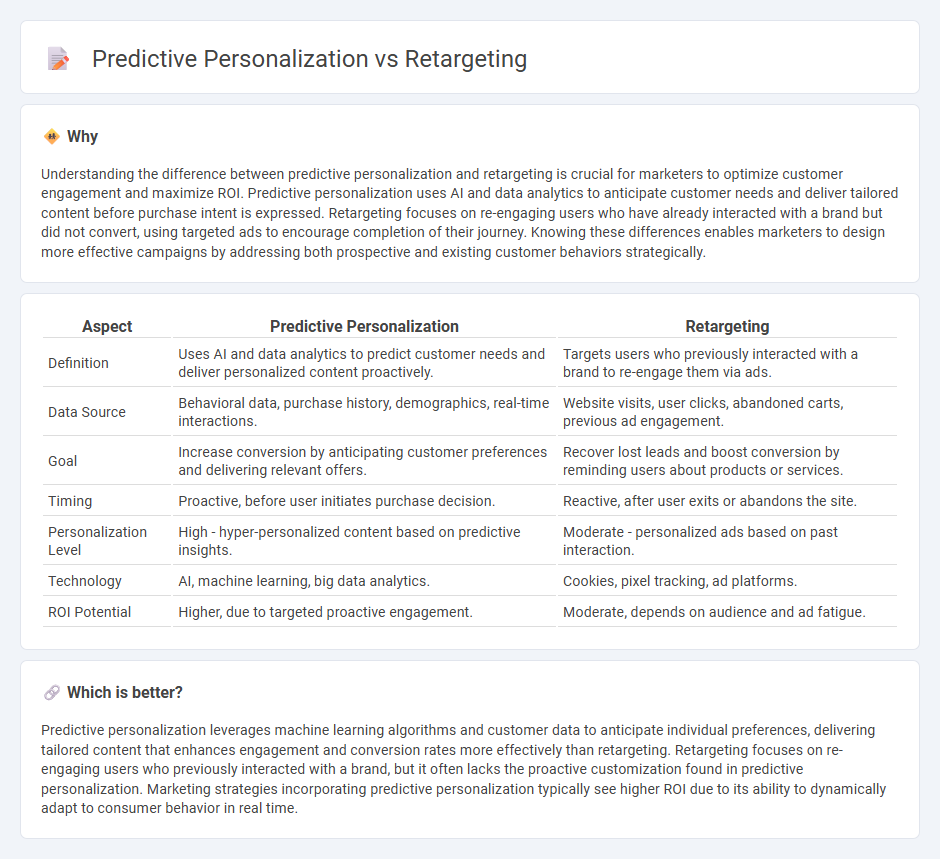
Predictive personalization leverages AI and machine learning to analyze customer behavior and anticipate future needs, creating highly tailored marketing experiences. Retargeting focuses on reconnecting with users who have previously interacted with a brand by displaying targeted ads across various platforms. Discover how integrating these strategies can maximize engagement and boost conversion rates.
Why it is important
Understanding the difference between predictive personalization and retargeting is crucial for marketers to optimize customer engagement and maximize ROI. Predictive personalization uses AI and data analytics to anticipate customer needs and deliver tailored content before purchase intent is expressed. Retargeting focuses on re-engaging users who have already interacted with a brand but did not convert, using targeted ads to encourage completion of their journey. Knowing these differences enables marketers to design more effective campaigns by addressing both prospective and existing customer behaviors strategically.
Comparison Table
| Aspect | Predictive Personalization | Retargeting |
|---|---|---|
| Definition | Uses AI and data analytics to predict customer needs and deliver personalized content proactively. | Targets users who previously interacted with a brand to re-engage them via ads. |
| Data Source | Behavioral data, purchase history, demographics, real-time interactions. | Website visits, user clicks, abandoned carts, previous ad engagement. |
| Goal | Increase conversion by anticipating customer preferences and delivering relevant offers. | Recover lost leads and boost conversion by reminding users about products or services. |
| Timing | Proactive, before user initiates purchase decision. | Reactive, after user exits or abandons the site. |
| Personalization Level | High - hyper-personalized content based on predictive insights. | Moderate - personalized ads based on past interaction. |
| Technology | AI, machine learning, big data analytics. | Cookies, pixel tracking, ad platforms. |
| ROI Potential | Higher, due to targeted proactive engagement. | Moderate, depends on audience and ad fatigue. |
Which is better?
Predictive personalization leverages machine learning algorithms and customer data to anticipate individual preferences, delivering tailored content that enhances engagement and conversion rates more effectively than retargeting. Retargeting focuses on re-engaging users who previously interacted with a brand, but it often lacks the proactive customization found in predictive personalization. Marketing strategies incorporating predictive personalization typically see higher ROI due to its ability to dynamically adapt to consumer behavior in real time.
Connection
Predictive personalization leverages data analytics and machine learning to anticipate customer preferences and behavior, enabling highly tailored marketing messages. Retargeting uses this predictive insight to deliver customized ads to users who have previously interacted with a brand, increasing conversion rates. Integrating predictive personalization with retargeting enhances campaign efficiency by targeting individuals with the most relevant content at optimal times.
Key Terms
Retargeting:
Retargeting uses data from user interactions to display targeted ads, increasing conversion rates by re-engaging potential customers who have shown prior interest. It leverages cookies and tracking pixels to serve relevant ads across platforms, optimizing ad spend and enhancing brand recall. Explore more to understand how retargeting strategies drive customer retention and ROI.
Cookies
Retargeting uses cookies to track users' past interactions and serve ads based on their previous behavior, while predictive personalization employs cookies along with AI algorithms to analyze patterns and predict future user preferences. Cookies enable both strategies to collect data, but predictive personalization leverages this data to create more individualized experiences beyond simple ads. Explore how cookie data shapes retargeting and predictive personalization for enhanced marketing results.
Ad Impressions
Retargeting focuses on serving ads to users who have previously interacted with a brand, leveraging historical behavior to increase ad impressions and conversion rates. Predictive personalization uses machine learning algorithms to anticipate future user preferences, optimizing ad impressions by delivering more relevant and timely content. Explore more to understand the best strategies for maximizing ad impressions through these approaches.
Source and External Links
Retargeting: Definition, Types and How-tos - AdRoll - Retargeting is a digital marketing tactic that serves tailored ads to users based on prior engagement, aiming to re-engage visitors who left without purchasing by using cookies and retargeting pixels to remind them of products as they browse elsewhere online.
Retargeting | Digital Advertising Glossary - Criteo - Retargeting includes site retargeting (targeting visitors who left a site without buying), search retargeting (ads based on keyword searches), social media retargeting, and email retargeting, all focused on re-engaging users with personalized ads or messages to increase conversions.
What is Ad Retargeting? - Mailchimp - Retargeting shows relevant ads to visitors who did not buy during their first visit, helping businesses bring back 97% of users who leave without purchasing by increasing brand visibility and the chance of conversion through repeated ad exposure.
 dowidth.com
dowidth.com